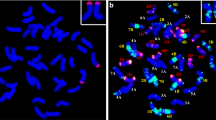Abstracts
A striking feature of Triticum carthlicum Nevski (2n = 4x = 28, AABB genome) is an awn-like appendage on the glume, so all the spikelets appear four-awned. From the word “tetraaristatus” (four-awned), the locus was named “t” to distinguish it from the b 1 locus on chromosome 5A and b2 locus on chromosome 6B for awn formation. The aims of present study was to determine the chromosomal location of the t locus in tetraploid wheat T. carthlicum, and (2) to assess linkage relationships of t, Rht12 using microsatellite markers in T. carthlicum. Combined cytological evidence and microsatellite mapping showed that t was located on the chromosome 5AL. The alignment of the gene was Xgwm291–(6.4 cM)–t–(6.7 cM)–Xgwm410 in F2 of T. carthlicum #521/LD222, and Xhbg219–(12.4 cM)–t–(5.1 cM)–Xgwm410–(6.2 cM) –Rht12 in F2 of ANW 16C/#521 on the 5AL. The t locus was different from b1 locus, because it was known that the semi-dwarf Rht12 gene was completely linked with b1 gene. We discussed that the four-awned phenotype of T. carthlicum was introduced from Triticum aestivum L. ssp. carthlicoides.




Similar content being viewed by others
References
Börner A, Plaschke J, Korzun V, Worland AJ (1996) The relationships between dwarfing genes of wheat and rye. Euphytica 89:69–75
Gandilyan PA (1972) Spontaneous hybridization, mutations and some aspects of the phylogeny of wheat. Sov Genet (English version of Genetika) 8:949–960
Joppa LR, Williams ND (1988) Langdon durum substitution lines and aneuploid analysis in tetraploid wheat. Genome 30:222–228
Kosambi DD (1944) The estimation of map distances from recombination values. Ann Eugen 12:172–175
Kosuge K, Watanabe N, Kuboyama T, Melnik VM, Yanchenko VI, Rosova MA, Goncharov NP (2008) Cytological and microsatellite mapping of mutant genes for spherical grain and compact spikes in durum wheat. Euphytica 159:289–296
Kuckuck H (1979) On the origin of Triticum carthlicum NEVSKI (=Triticum persicum VAV.). Wheat Inform Serv 50:1–5
Muramatsu M (1986) The vulgare super gene Q: its universality in durum wheat and its phenotypic effect in tetraploid and hexaploid wheat. Can J Genet Cytol 28:30–41
Rao MVP (1981) Telocentric mapping of the awn inhibitor gene Hd on chromosome 4B of common wheat. Cereal Res Comm 9:335–337
Röder MS, Korzun V, Wendehake K, Plaschke J, Tixier M-H, Leroy P, Ganal MW (1998) A microsatellite map of wheat. Genetics 149:2007–2023
Sears ER (1954) The aneuploids of common wheat. Missouri Agric Exp Station Res Bull No 572, pp. 1–58
Song QJ, Shi JR, Singh S, Fikus EW, Costa JM, Lewis J, Gill BS, Ward R, Cregan PB (2005) Development and mapping of microsatellite (SSR) markers in wheat. Theor Appl Genet 110:550–560
Torada A, Koike M, Mochida K, Ogihara Y (2006) SSR-based linkage map with new markers using an intraspecific population of common wheat. Theor Appl Genet 112:1042–1051
Worland AJ, Sayer EJ, Borner A (1994) The genetics and breeding potential of Rht12, a dominant dwarfing gene in wheat. Plant Breed 113:187–196
Acknowledgments
NW thanks Dr. D.L. Klindworth and Sr. S.S. Xu, USDA-ARS, Fargo, USA, the USDA-ARS, National Small Grain Collection, Aberdeen, Idaho, USA, the late Prof. P. Gandliyan, Armenia, and Dr. N.P. Goncharov, Institute of Cytology and Genetics, Novosibirsk, Russia, for providing seed for these experiments. Dr. M.S. Röder, IPK Gatersleben, Germany and Dr. A. Torada, Hokkaido Green-Bio Institute, Naganuma, Hokkaido, Japan provided unpublished primer sequences of microsatellite markers. Part of this study was done at the experimental facility of the Faculty of Applied Biological Sciences, Gifu University, Japan. Excellent technical assistance by Miss Yumiko Koga is gratefully acknowledged.
Author information
Authors and Affiliations
Corresponding author
Rights and permissions
About this article
Cite this article
Haque, M.A., Takayama, A., Watanabe, N. et al. Cytological and genetic mapping of the gene for four-awned phenotype in Triticum carthlicum Nevski. Genet Resour Crop Evol 58, 1087–1093 (2011). https://doi.org/10.1007/s10722-010-9644-7
Received:
Accepted:
Published:
Issue Date:
DOI: https://doi.org/10.1007/s10722-010-9644-7




